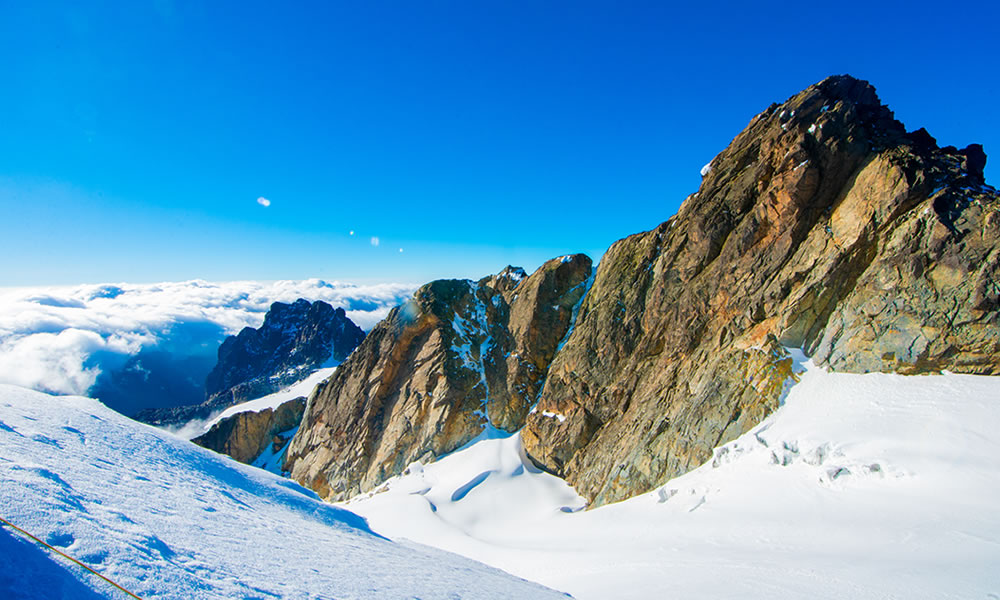Mountain Situated between Uganda and the Democratic Republic of the Congo (DRC), Rwenzori National Park is a UNESCO World Heritage Site that shares a boundary with the DRC’s Virunga National Park. In the Ugandan district of Kasese, the Rwenzori Mountains cover an area of roughly 996 km. The second-highest peak in Africa, Margherita Peak, is part of the highest ranges in the Rwenzori Mountains National Park, a free-standing, snow-covered block mountain. The six mountains that make up Mountain Rwenzori National Park are just a few miles north of the equator. The highest peak, Mount Stanley, is 5,109 metres high. Baker is next highest at 4843 metres, and Speke is the highest at 4890 metres. What’s fascinating about these peaks is that non-seasonal glaciers completely cover them. You can see these peaks from Queen Elizabeth National Park and Virunga National Park.

Attractions in Mountain Rwenzori National Park
In addition to the rarest plant species in the world, the fauna of Mountain Rwenzori National Park includes over 70 animal species, 217 bird species, and 19 unique species from the Albertine Rift. These mountains are situated close to the Uganda-Congo border in western Uganda. The park holds cultural significance for the surrounding villages as well.
Activities in Mountain Rwenzori National Park
Mountain Climbing
Climbing Mount Rwenzori is a hidden treasure that not many tourists get to experience. Some have referred to the mountain’s scenery as some of the most breathtaking on the entire earth! As you ascend its heights, the diverse vegetation and environment of the Mountain Rwenzori will captivate you. Climbing Mount Rwenzori will provide you with stunning landscapes and submontane vegetation in the Afro-montane zone, which is covered in opulent tropical evergreen forests that are highly diverse in terms of colour and species. You will be overcome with emotion and gasp in awe at the sight of the magnificent snow-capped peaks when you eventually reach the summit.
Bird Watching
The mountain Rwenzori offers abundant opportunities for bird viewing, and the ranges are no exception. There are 217 different species of birds in the Rwenzori Park, and 17 of them are unique to the area, earning it the designation of UNESCO Important Birding Area. You will be enthralled by the variety at around 1800 metres, which includes the Handsome Francolin, Rwenzori Turaco, Long-eared Owl, Barred Long-tailed Cuckoo, Cinnamon-chested Bee-eater, Strange Weaver, White-starred Robin, Rwenzori Batis, Blue-headed Sunbird, Barbets, Golden-winged Sunbird, Lagden’s Bush Shrike, Greenbuls, IIladopsis, Apalises, Crimson wings, and Flycatchers.
Hiking in Rwenzori Mountain
Climbing Mount Hiking The hiking in Rwenzori National Park gets harder as you move higher, making it a landmark that you won’t soon forget. Your breathing becomes more difficult and you feel as though something heavy is crushing down on your chest due to a lack of oxygen in the higher regions. These are all impacts of altitude. Unlike the lofty, single-standing volcanoes of Kilimanjaro or Mount Kenya, the Rwenzori mountain range has an unparalleled landscape, with the largest glaciers in Africa. It is also incredibly picturesque. Hiking either the Kilembe Trail or the Central Circuit Trail will get you to the margarita peak.
Cultural Encounter
A journey to a different culture will take you on trails like the Rwenzori Turaco View Nature Walk, which is home to the Bakonjo tribe. The Bakonjo tribe is said to have existed for almost 300 years, during which time they have adjusted their way of life to the harsh environment and verdant slopes of the Rwenzori foothills. Experience the nature and culture of Rwenzori Mountain by hiking the Turaco View Campsite Trail, which is situated along the Congolese border and leads to Mountain Rwenzori National Park. The Ruboni Forest Walk provides numerous possibilities to observe the people living in the slopes of the Moon Mountain performing traditional dances and other cultural activities.
What to come with
It is advised that you bring your own equipment or rent it from the National Park headquarters. Items to bring include a rucksack, a sleeping mat and sleeping bag for cold weather, one plate, cutlery, a mug, a knife, gumboots, waterproof trousers, a raincoat or poncho, a heavy-duty worm jacket, hand gloves, a scarf, a cup, a jumper, a torch and a bottle of water. Crampons, snow gloves, snow goggles, climbing boots, a rope, and an ice axe are additional pieces of equipment needed for anyone planning to climb the summits. With the admittance package, each passenger receives the assistance of four porters who will handle the majority of the luggage and an experienced guide, therefore you are not allowed to bring bags that weigh more than 15 kg.
Best time to climbing Mountain Rwenzori
Although you can hike and climb Mount Rwenzori year-round, the ideal months to do so are July–August and December–February. Since these are typically Uganda’s dry months, hiking and mountain climbing are more accessible.
